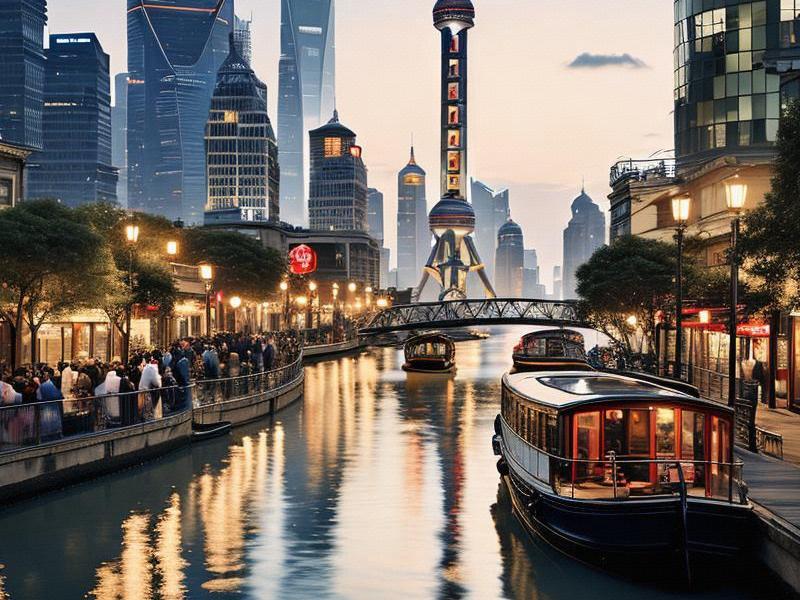Shanghai, a vibrant and dynamic city located on the banks of the Huangpu River in eastern China, stands as a testament to the country's rapid urbanization and economic transformation. Over the past few decades, Shanghai has evolved from a historic port city into a global financial center, a cultural melting pot, and a symbol of modernity in China.

Shanghai's history dates back to the 11th century when it was a small fishing village. However, its significance grew with the opening of the Treaty Ports in the mid-19th century following the First Opium War. The city quickly became a major international trading hub, attracting merchants and settlers from around the world. This period of foreign influence left a lasting legacy on Shanghai's architecture, culture, and cuisine.
The Bund, a waterfront area along the Huangpu River, is a prime example of this historical blend. Once home to numerous foreign concessions, the Bund features a stunning array of Art Deco, Gothic, and neoclassical buildings that stand as a reminder of Shanghai's colonial past. Today, the Bund is a popular tourist destination, offering breathtaking views of the modern skyline across the river in Pudong.
In the latter half of the 20th century, Shanghai experienced significant changes as China underwent economic reforms. In 1990, the Chinese government established the Shanghai Pudong New Area, marking the beginning of a new era for the city. Pudong, once a rural area, has since transformed into a symbol of China's economic prowess, housing some of the tallest skyscrapers in the world, including the iconic Oriental Pearl Tower, the Jin Mao Tower, and the Shanghai Tower.
The Lujiazui Financial District, located in Pudong, is the heart of Shanghai's financial industry. It is home to the Shanghai Stock Exchange, the largest stock exchange in mainland China, and a plethora of multinational corporations and financial institutions. The district's skyline, illuminated at night, is a visual representation of Shanghai's status as a global financial hub.
Beyond its economic achievements, Shanghai is also known for its rich cultural heritage and vibrant arts scene. The city boasts numerous museums, galleries, theaters, and music venues that showcase both traditional Chinese art and contemporary works. The Shanghai Museum, housed in a former bank building, is renowned for its extensive collection of ancient Chinese art, including ceramics, bronzes, and calligraphy.
爱上海最新论坛
The city's commitment to preserving its cultural heritage is evident in the restoration of historic neighborhoods such as the French Concession and the Old City. These areas, with their narrow streets, colonial architecture, and local shops, offer a glimpse into the city's past while coexisting with modern developments.
Shanghai's culinary scene is another aspect that reflects its diverse influences. From traditional Shanghainese dishes like xiaolongbao (soup dumplings) and shengjianbao (pan-fried buns) to international cuisines, the city offers a wide range of dining options. The vibrant night markets and bustling food streets are a testament to the city's culinary diversity and the passion of its people for food.
Education is a key pillar of Shanghai's development, and the city is home to some of the best universities and research institutions in China. Fudan University and Tongji University are among the most prestigious institutions, attracting students and scholars from around the world. Shanghai's emphasis on education and innovation has contributed to its reputation as a global knowledge hub.
Sustainability and environmental concerns are also at the forefront of Shanghai's urban planning. The city has implemented various initiatives to reduce pollution, promote green spaces, and improve public transportation. The Maglev train, which connects Pudong International Airport to the city center, is a high-speed, low-emission mode of transport that exemplifies Shanghai's commitment to sustainable development.
上海龙凤419足疗按摩
Shanghai's role in global affairs is further highlighted by its hosting of major international events. The city successfully hosted the World Expo in 2010, attracting millions of visitors and showcasing China's achievements and aspirations. The Expo's theme, "Better City, Better Life," resonated with the global community and underscored Shanghai's vision for sustainable urban development.
As Shanghai continues to grow and evolve, it faces challenges such as managing urban sprawl, ensuring equitable development, and addressing environmental issues. However, the city's resilience, innovation, and determination to remain a global leader position it well for the future.
The integration of technology and smart city initiatives is shaping the future of Shanghai. The city is investing in digital infrastructure, artificial intelligence, and data analytics to enhance governance, improve public services, and drive economic growth. Smart traffic management systems, e-governance platforms, and digital payment solutions are just a few examples of how Shanghai is embracing innovation to crteeaa more connected and efficient urban environment.
Shanghai's relationship with its neighboring cities and regions is also evolving. As part of the Yangtze River Delta Economic Zone, Shanghai collaborates with cities like Nanjing, Hangzhou, and Suzhou to promote regional integration and coordinated development. This collaboration aims to leverage the strengths of each city and crteeaa more competitive and innovative economic cluster.
上海龙凤419是哪里的
Culturally, Shanghai remains a beacon of openness and inclusivity. The city's cosmopolitan atmosphere attracts people from all over the world, creating a rich tapestry of cultures, languages, and traditions. This diversity enriches the city's social fabric and contributes to its creative and entrepreneurial spirit.
Tourism plays a significant role in Shanghai's economy, with millions of domestic and international visitors drawn to its attractions, shopping, and dining experiences. The city's tourism industry is continuously evolving to meet the needs of visitors, offering a wide range of experiences from luxury stays to cultural tours and adventure activities.
In conclusion, Shanghai is a city of contrasts and complexities, where the old and the new coexist harmoniously. Its journey from a historic port city to a global metropolis is a story of resilience, innovation, and ambition. As Shanghai looks to the future, it remains committed to its vision of becoming a world-class city that balances economic prosperity, cultural richness, and environmental sustainability.